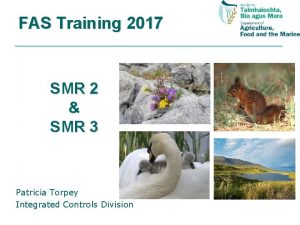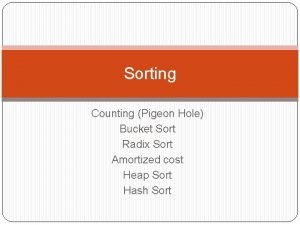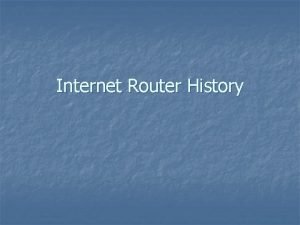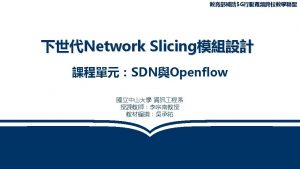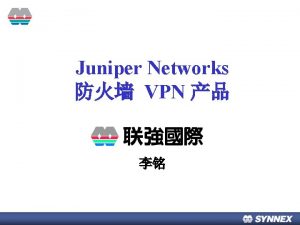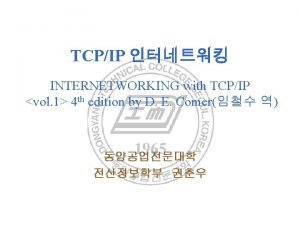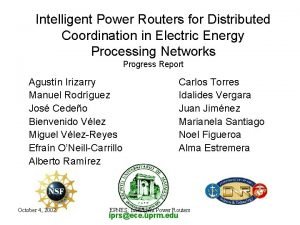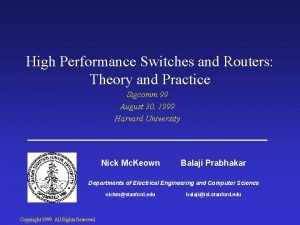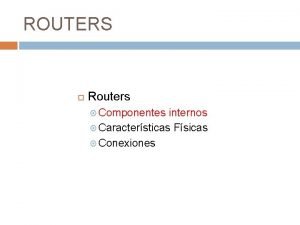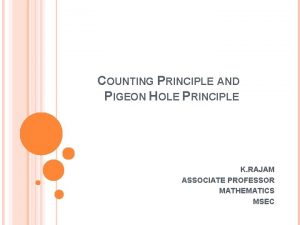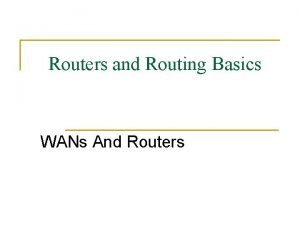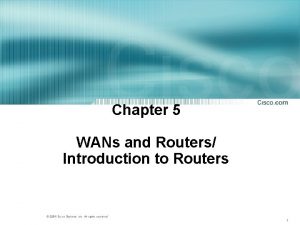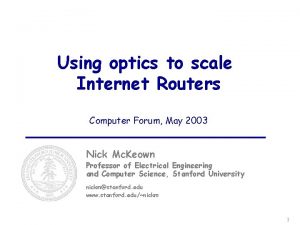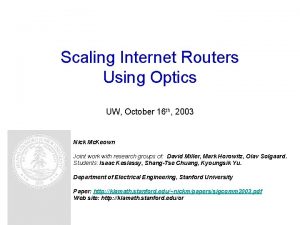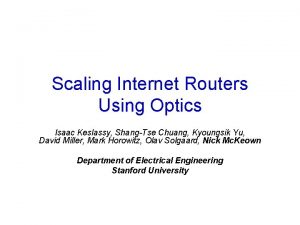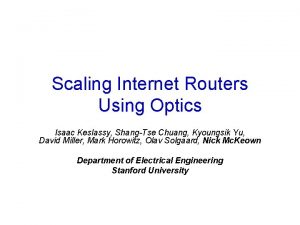Internet Routers II Using the Pigeon Hole Principle






























- Slides: 30

Internet Routers –II Using the Pigeon Hole Principle to Model Routers Stochastic Networks Seminar March 1 st 2002 Sundar Iyer High Performance Networking Group, Department of Computer Science, Stanford University sundaes@stanford. edu http: //www. stanford. edu/~sundaes

Using the Pigeon Hole Principle to Model Routers 1. Background 2. The Single Buffered Model for Routers 3. An Abstraction of a Switch Using Pigeons 4. Analysis of First In First Out Switches 5. Analysis of Delay Guarantees in Switches 6. Summary of Results Technique: Constraint Sets. Parallel Shared Memory Router Distributed Shared Memory Router Parallel Shared Memory Switch 2

What is an Ideal Router? R 1 1 R NR R N N R Total Bandwidth: N 2 R Arriving Packets Interconnect Memory Departing Packets Output Queued Switch v Output Queued (OQ) routers are ideal but not practical ü It minimizes the delay faced by a packet The bandwidth to each output is NR, the total bandwidth is N 2 R The cost and power consumption is prohibitive 3

CIOQ Models Arbiter R 1 1 R 2 R R N N N memories Total Bandwidth: NR Arriving Packets Departing Packets Input Queued Switch v R R R 2 R N N N memories Total Bandwidth: 2 NR Arriving Packets R N memories Departing Packets Combined Input-Output Queued Switch CIOQ switches offer some advantages over OQ switches, but are still not practical ü ü They can give the same delay guarantees as OQ switches They need a switching bandwidth of only 2 NR They have high computational complexity The model does not capture many different architectures 4

Using the Pigeon Hole Principle to Model Routers 1. Background 2. The Single Buffered Model for Routers 3. An Abstraction of a Switch Using Pigeons 4. Analysis of First In First Out Switches 5. Analysis of Delay Guarantees in Switches 6. Summary of Results Technique: Constraint Sets. Parallel Shared Memory Router Distributed Shared Memory Router Parallel Shared Memory Switch 5

The Single Buffered Router Model R 1 1 R N N Arriving Packets v Interconnect Memory Interconnect R R Departing Packets Single Buffered Routers buffer packets only once • The interconnects may be – physically separate or merged – one of the interconnects may be a simple pass through • The memory can be – centralized or distributed – one or many – statically or dynamically allotted amongst all ports 6

Why a New Model for Routers? v SB Routers comprise a broader class of routers Ø Ø They replace the CIOQ model They also include other interesting router architectures such as the • Parallel packet switch, Parallel shared memory router, Distributed shared memory router, etc. v With this model we can compare these routers to an ideal router and answer Ø Ø Does a router give me the same delay guarantees as an output queued switch? Can a router give me 100% throughput 7

Parallel Packet Switch Slow Speed Output Queued Routers OQ NR/k 1 NR/k OQ rate, NR 2 rate, NR Departing Packets Arriving Packets NR/k OQ NR/k k 8

Parallel Shared Memory Router Slow Speed Parallel Memories 1 rate, NR 2 k 2 NR NR NR rate, NR Memory Manager Arriving Packets Departing Packets 9

Distributed Shared Memory Router Distributed Line Cards rate, R Arbiter 1 S 1 R S 2 R 1 rate, R 2 2 rate, R N N rate, R BW: S 1 NR BW: S 2 NR N memories Arriving Packets Departing Packets 10

How to Compare Routers? Output Queued Router OQ Switch R R 1 2 R N R 1 1 OQ R N =? Single Any Buffered Router SB Switch 1 Yes? Emulate 2 R 1 No R N N R 11

Using the Pigeonhole Principle to Model Routers 1. Background 2. The Single Buffered Model for Routers 3. An Abstraction of a Switch Using Pigeons 4. Analysis of First In First Out Switches 5. Analysis of Delay Guarantees in Switches 6. Summary of Results Technique: Constraint Sets Parallel Shared Memory Router Distributed Shared Memory Router Parallel Shared Memory Switch 12

An Abstract Model for a Router A Modified Pigeonhole Principle v Consider the following model for a switch Ø Ø There are P pigeonholes, that can contain an infinite number of pigeons Assume that time is slotted, and in any one time slot T, • at most N pigeons can arrive and at most N can depart • at most one pigeon can enter or leave a specific pigeonhole Ø v When a pigeon arrives, we know the exact time slot at which it will depart For any switch: Ø We need to determine the minimum P, such that all N pigeons can be immediately placed in a pigeonhole when they arrive, and can depart at the right time 13

Solving the Abstract Model v When a pigeon arrives in a time slot Ø Ø Ø v No more than N – 1 other pigeons arrive at that timeslot No more than N other pigeons depart at that timeslot No more than N - 1 other pigeons depart at the same time as this pigeon By the Pigeonhole Principle, Ø P = [(N) + (N-1)] + 1 = 3 N – 1 pigeonholes are sufficient 14

The Constraint Set Technique Upon arrival of a packet, find a memory which is free now and which is free when it will depart 15

What prevents us from finding such free memories? v Physical Constraints, which are limitations imposed by the hardware Ø Ø Ø Memory: (E. g. Parallel Shared Memory Router) Can’t access a memory more than a certain number of times in a time period Bus: (E. g. Parallel Packet Switch) Can’t use the same bus simultaneously for more than a certain number of packets Crossbar: (E. g. Distributed Shared Memory Router) Each port -input and port-output may be busy only once in a timeslot 16

Using the Pigeon Hole Principle to Model Routers 1. Background 2. The Single Buffered Model for Routers 3. An Abstraction of a Switch Using Pigeons 4. Analysis of First In First Out Switches 5. Analysis of Delay Guarantees in Switches 6. Summary of Results Technique: Constraint Sets Parallel Shared Memory Router Distributed Shared Memory Router Parallel Shared Memory Switch 17

An Example: Parallel Shared Memory (PSM) Router Number Memories BW per Memory Total BW Emulate? 2 N R 2 NR ? ? DRAM consisting of k memories 2 NR Write Access Time = T Read Access Time = T R R 1 1 2 2 R Number Memories BW per Memory Total BW Emulate? 3 N R 3 NR FIFO 4 N R 4 NR Delay R N N Arbiter Arriving Packets Departing Packets 18

Can a PSM Router Emulate a FIFO OQ Router? Let a cell arrive at input “i” at time “t” and be destined to depart from output port “j” at time “DT” v Such a cell must not be written to memories which v 1. Are used to write the other N-1 arriving cells at t. (Write Constraint Set) 2. Are used to read the N departing cells at t. (Read Constraint Set) 3. Will be used to read the N-1 departing cells at DT. (Future Read Constraint Set) There are three constraint sets v Ø By the pigeonhole principle, 3 N memories at rate R, or a memory bandwidth of 3 NR is sufficient 19

Using the Pigeon Hole Principle to Model Routers 1. Background 2. The Single Buffered Model for Routers 3. An Abstraction of a Switch Using Pigeons 4. Analysis of First In First Out Switches 5. Analysis of Delay Guarantees in Switches 6. Summary of Results Technique: Constraint Sets Parallel Shared Memory Router Distributed Shared Memory Router Parallel Shared Memory Switch 20

Distributed Shared Memory Router Arbiter R R 1 1 S 1 R S 2 R R R N No. Mem BW per Mem. Total BW Xbar speed Emulate? N 4 R 4 NR FIFO N 6 R 6 NR Delay N BW: S 1 NR BW: S 2 NR N memories Arriving Packets Departing Packets 21

Can a DSM Router Emulate a FIFO OQ Router? Let a cell arrive at input “i” at time “t” and be destined to depart from output port “j” at time “DT” Ø The cell can be written to any intermediate port “x” such that Ø 1. The edge (i, x) is available at time t. Since, no more than N-1 other cells contend to write at time t, no more than floor[(N-1)/s 1] vertices are unavailable. (Write Constraint Set) 2. The edge (x, j) is available at time DT. Since, no more than N-1 other cells contend to leave at time DT, no more than floor[(N-1)/s 2] vertices are unavailable. (Read Constraint Set) There are two constraint sets Ø • • • By the pigeonhole principle, if suffices that floor[(N-1)/s 1] + floor[(N-1)/s 2] < N. Hence if s 1 =s 2 =2, i. e. s=s 1+s 2=4 is enough. A bandwidth of 4 NR is sufficient 22

Using the Pigeon Hole Principle to Model Routers 1. Background 2. The Single Buffered Model for Routers 3. An Abstraction of a Switch Using Pigeons 4. Analysis of First In First Out Switches 5. Analysis of Delay Guarantees in Switches 6. Summary of Results Technique: Constraint Sets Parallel Shared Memory Router Distributed Shared Memory Router Parallel Shared Memory Switch 23

An Abstraction of Delay Guarantees 1 Push In First Out (PIFO) Queue = 4 FIFO queues on a single output v Requirement A 2 = 2 Ø Ø Ø v B 1 = 3 Multiple FIFO Queues need to be maintained An arriving packet joins one of the FIFO queues A server serves these queues with different weights D 2 C 3 B 1 A 1 = 4 C 3 = 2 C 2 = 1 D 2 = 2 A 1 D 1 C 1 = 1 D 1 = 1 C 2 C 1 Abstraction Ø Ø A single queue is maintained An arriving packet can be pushed anywhere into the queue The head of the queue is serviced Note: The relative order of cells of the same “color” does not change 24

What is the Problem with PIFO? v There are two problems • • Problem with PIFO: – The constraint set technique depends on being able to predict the departure time and schedule it. The departure time of a cell is not fixed in PIFO Problem with non PIFO order: – When the memory is shared amongst all outputs, the departure order for the router as a whole is not even PIFO, even though each output queue is a PIFO queue. Lets see what causes the latter problem… 25

What causes the non-PIFO Order? N=4 output ports shown in different colors, each of which is a PIFO queue. d 4 c 4 b 4 a 4 d 3 c 3 b 3 a 3 d 2 c 2 b 2 a 2 Departure Order a 3’ d 4 c 4 b 4 a 4 d 3 c 3 b 3 a 3 d 1 c 1 b 1 a 1 d 2 c 2 b 2 a 2 d 1 c 1 b 1 a 1 Relative order has changed. It is not PIFO! d 4 c 4 b 4 a 3 d 3 c 3 b 3 a 3’ Cannot prevent conflicts since a 3 is already written to memory ü Can prevent conflicts since a 3’ is being written now d 2 c 2 b 2 a 2 d 1 c 1 b 1 a 1 26

Steps in PIFO Scheduling Re-ordering the Output pattern d 5 c 5 b 5 a 5 d 4 c 4 b 4 a 4 d 3 c 3 b 3 a 3 d 2 c 2 b 2 a 2 d 1 c 1 b 1 a 8 a 7 a 6 a 5 d 4 d 3 d 2 d 1 c 4 c 3 c 2 c 1 b 4 b 3 b 2 b 1 a 4 a 3 a 2 a 1 a 3’ a 8 a 7 a 6 a 5 d 4 d 3 d 2 d 1 c 4 c 3 c 2 c 1 b 4 b 3 b 2 b 1 a 4 a 3 a 2 a 1 a 7 a 6 a 5 a 4 d 3 d 2 d 1 c 4 c 3 c 2 c 1 b 4 b 3 b 2 b 1 a 3’ a 2 a 1. . ü Due to future pushes a 3’ may end up with a 3, a 4, a 5 ü Due to future pushes a 3’ may end up with a 2, a 1, a 0, . . ü Can prevent conflicts by taking care of past and future N cells 27

Can a PSM Router Emulate a PIFO OQ Router? A cell which arrives at input “i” at time “t”, destined to depart output port “j” at time “DT” , must not be written to memories which v 1. 2. 3. 4. Are used to write the other N-1 arriving cells at t. (Write Constraint Set) Are used to read the N departing cells at t. (Read Constraint Set) Will be used to read the N-1 departing cells of that output before it (Future Read Constraint Set) Will be used to read the N-1 departing cells of that output after it (Future Read Constraint Set) There are four constraint sets v Ø By the pigeonhole principle, 4 N memories at rate R, or a memory bandwidth of 4 NR is sufficient 28

Using the Pigeon Hole Principle to Model Routers 1. Background 2. The Single Buffered Model for Routers 3. An Abstraction of a Switch Using Pigeons 4. Analysis of First In First Out Switches 5. Analysis of Delay Guarantees in Switches 6. Summary of Results Technique: Constraint Sets Parallel Shared Memory Router Distributed Shared Memory Router Parallel Shared Memory Switch 29

Summary Type Num. Mem. BW of Mem. Total BW Arbiter Emulate? OQ N (N+1)R None Yes Shared Memory 1 2 NR Simple Yes IQ N 2 R 2 NR Moderate No CIOQ 2 N 3 R 6 NR Complex Yes PSM k 4 NR/k 4 NR Simple Yes DSM N 6 R 6 NR Simple Yes PPS Nk 6 R/k 6 NR Simple Yes 30
 Rock pigeon vs feral pigeon
Rock pigeon vs feral pigeon Pigeonhole sorting
Pigeonhole sorting Pigeonhole principle examples
Pigeonhole principle examples Pigeon principle examples
Pigeon principle examples Pigeon dissection labeled
Pigeon dissection labeled Ecole pigeon vole bouvignies
Ecole pigeon vole bouvignies Pigeon
Pigeon Dodo passenger pigeon and stellers
Dodo passenger pigeon and stellers Pigeon mail merge
Pigeon mail merge South australian homing pigeon
South australian homing pigeon Columbidos
Columbidos Pigeon farm business
Pigeon farm business Heart parts
Heart parts What is pigeon chest
What is pigeon chest Pigeon pose diagram
Pigeon pose diagram Wifi router history
Wifi router history Small business rv router
Small business rv router Business class telecom
Business class telecom Sdn architecture vs traditional network
Sdn architecture vs traditional network Three dumb routers
Three dumb routers Juniper ptx packet transport routers
Juniper ptx packet transport routers Routers
Routers Confidendial
Confidendial Routers.
Routers. High performance switches
High performance switches Routers internos
Routers internos Show that the maximum efficiency of pure aloha is 1/(2e)
Show that the maximum efficiency of pure aloha is 1/(2e) Hnd router
Hnd router Systems integration specialists
Systems integration specialists High performance switches and routers
High performance switches and routers Internet or internet
Internet or internet
